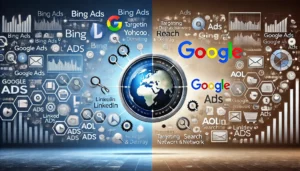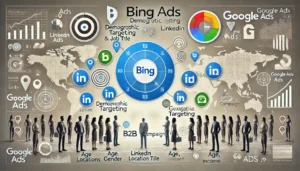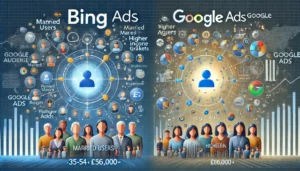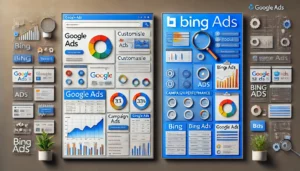Bing Ads vs Google Ads: Which is Right for You?

Choosing between Bing Ads vs Google Ads can be tricky. Both platforms have their strengths and weaknesses. While Google Ads has a larger audience, Bing Ads often offers lower costs. Understanding the differences can help you decide which is best for your business.
Key Takeaways
- Google Ads has a much larger audience compared to Bing Ads.
- Bing Ads often have lower cost-per-click (CPC) rates.
- Both platforms offer various targeting options like demographic and geographic targeting.
- Google Ads generally provide higher click-through rates (CTR) and conversion rates.
- Using both platforms can help you reach a broader audience and maximise your ad spend.
Understanding the Basics of Bing Ads and Google Ads
Overview of Bing Ads
Bing Ads, owned by Microsoft, allows businesses to advertise across three search engines: Bing, Yahoo, and AOL. This means when you run a campaign on Bing Ads, your ads appear on all three platforms. This can be a great way to reach a broader audience. Bing Ads also offers unique features like LinkedIn profile targeting, which can be particularly useful for B2B marketing.
Overview of Google Ads
Google Ads, formerly known as Google AdWords, is the most popular pay-per-click (PPC) advertising platform. It consists of two main networks: the Search Network and the Display Network. The Search Network shows text ads on Google search results, while the Display Network displays visual ads on over 2 million websites. Google Ads is known for its extensive reach and advanced targeting options.
Key Differences Between Bing Ads vs Google Ads
While both platforms aim to help businesses reach their target audience and drive traffic, there are some key differences:
- Reach: Google Ads has a larger audience due to Google’s dominance in the search engine market. Bing Ads, however, can still reach a significant number of users, especially in certain demographics.
- Cost: Generally, the cost per click (CPC) is lower on Bing Ads compared to Google Ads. This can make Bing a more cost-effective option for some businesses.
- Targeting Options: Both platforms offer robust targeting options, but Google Ads provides more advanced features like custom intent audiences and detailed demographic targeting.
Understanding these basics can help you decide which platform might be better suited for your advertising needs. Each has its own strengths and can be used effectively depending on your goals and budget.
Cost Comparison: Bing Ads vs Google Ads
Budgeting for Bing Ads
Budgeting for Bing Ads can be more flexible due to its lower CPC. Businesses can allocate a smaller budget and still achieve significant reach and engagement. This is particularly beneficial for small to medium-sized enterprises (SMEs) looking to maximise their advertising spend without breaking the bank.
Budgeting for Google Ads
On the other hand, Google Ads, despite its higher costs, offers unparalleled reach and targeting capabilities. Google AdWords PPC campaigns can be more expensive, but they often deliver higher conversion rates and a broader audience. This makes Google Ads a preferred choice for businesses aiming for extensive reach and higher visibility.
While Bing Ads can be more cost-effective, Google Ads often provides a better return on investment due to its extensive reach and advanced targeting options.
In conclusion, both platforms have their unique advantages. Bing Ads is ideal for cost-conscious businesses, while Google Ads is better suited for those looking to achieve maximum reach and impact.
Targeting Capabilities of Bing Ads and Google Ads
Demographic Targeting
When it comes to demographic targeting, both Bing Ads and Google Ads offer robust options. Google Ads allows us to target users based on age, gender, parental status, and household income. Bing Ads, on the other hand, provides similar demographic targeting but with an added advantage of LinkedIn profile targeting. This feature is particularly useful for B2B campaigns, allowing us to reach professionals based on their job titles, companies, and industries.
Geographic Targeting
Geographic targeting is another area where both platforms excel. Google Ads offers precise location targeting, enabling us to target users by country, region, city, or even a specific radius around a location. Bing Ads also provides comprehensive geographic targeting options, but it shines with its ability to target users based on their device’s location settings. This can be particularly beneficial for local businesses looking to attract nearby customers.
Device Targeting
Device targeting is crucial in today’s multi-device world. Google Ads allows us to target users based on the device they are using, whether it’s a desktop, tablet, or mobile. Bing Ads takes it a step further by offering more granular control over device targeting. We can target specific operating systems and even exclude certain devices from our campaigns. This level of control can help us optimise our ad spend and ensure our ads are shown on the most relevant devices.
Pro Tip: Utilising the unique targeting features of each platform can significantly enhance your campaign’s performance. For instance, leveraging LinkedIn profile targeting on Bing Ads can be a game-changer for B2B marketers.
In summary, while Google Ads offers a broader range of targeting options, Bing Ads provides unique features that can be highly beneficial depending on your campaign goals. Understanding these differences can help us make more informed decisions and maximise our ad spend.
Ad Formats and Features: Bing Ads vs Google Ads
Ad Formats in Bing Ads
Bing Ads offers a variety of ad formats to suit different marketing needs. These include:
- Expanded Text Ads: These ads provide more space to convey your message, similar to Google Ads.
- Dynamic Search Ads: These ads are generated based on your website content, saving time and filling in gaps.
- Product Ads/Shopping Ads: These ads showcase your products visually, including prices, titles, and images.
- Responsive Search Ads: You provide multiple headlines and descriptions, and Bing mixes and matches them for the best performance.
- Microsoft Audience Ads: These banner ads are placed contextually across various websites, offering a seamless on-page experience.
Ad Formats in Google Ads
Google Ads also provides a wide range of ad formats, each designed to meet specific marketing goals. These include:
- Search Ads: Text-based ads that appear on Google search results.
- Shopping Ads: These ads display product images, prices, and descriptions, ideal for e-commerce.
- Display Ads: These can be images, videos, or text ads shown across Google’s vast network of websites and apps.
- Video Ads: These ads run on YouTube and across the Google Display Network.
- Gmail Ads: Expandable ads that appear at the top of users’ Gmail inboxes.
- Responsive Display Ads: You provide the assets, and Google automatically generates ads in various sizes and formats.
Unique Features of Each Platform
Both Bing Ads and Google Ads have unique features that set them apart:
- Bing Ads: One standout feature is LinkedIn profile targeting, which is especially useful for B2B marketing. Bing also offers specialised mobile search ads, allowing users to narrow their focus to specific search results.
- Google Ads: Google provides immediate visibility on the top page of search results, offering a quick way to showcase products or services. The platform also supports a wide range of ad formats, including video and app ads, making it versatile for different marketing objectives.
Instead of trying to increase the budget on a single campaign or platform, we work on creating a wide range of ads with predetermined budgets of different styles and on different platforms. Such as a variety of Google ads, Bing ads, Yelp ads, influencer ads, and a wide range of social media ads.
In summary, both platforms offer robust ad formats and unique features. Choosing the right one depends on your specific marketing needs and goals.
Performance Metrics: Bing Ads vs Google Ads
Click-Through Rate (CTR)
When it comes to Click-Through Rate (CTR), Google Ads generally leads the pack. On average, Google Ads boasts a CTR of 1.91% for its Search Network and 0.35% for its Display Network. In contrast, Bing Ads often sees a higher average CTR of 2.83%. This difference can be crucial depending on your campaign goals and target audience.
Conversion Rate
Conversion rates are another vital metric to consider. Google Ads typically has an average conversion rate of 3.75%, making it a strong contender for businesses focused on ecommerce PPC. Bing Ads, on the other hand, has a slightly lower average conversion rate of 2.94%. While this might seem like a disadvantage, Bing’s lower competition can sometimes lead to more cost-effective conversions.
Return on Investment (ROI)
Return on Investment (ROI) is often the ultimate measure of a campaign’s success. Google Ads generally offers a higher ROI due to its extensive reach and advanced targeting options. However, Bing Ads can provide a competitive ROI, especially for businesses targeting specific demographics or those conducting a Google ads audit. The key is to align your platform choice with your business goals and audience.
Understanding these metrics is crucial for effective PPC audit and campaign optimisation. By analysing CTR, conversion rates, and ROI, we can make informed decisions that maximise our ad spend and enhance profitability.
Audience Demographics and Reach: Bing Ads vs Google Ads
User Demographics on Bing
When we look at Bing users, we see a specific group. Most Bing users are married (43%), between 35-54 years old (40%), and earn over £76,000 a year (33%). This makes Bing a great choice if your target audience fits these demographics.
User Demographics on Google
Google users are generally younger. It’s harder to pinpoint exact demographics because Google has such a large audience. However, this large audience means you have a better chance of reaching your target, even if it’s a niche one.
Reach and Market Share
Google has a larger reach due to its dominance in the search engine market. Google Ads can reach 90% of online users through its Display Network. Bing, on the other hand, captures 34% of the desktop search engine market share. While Google reaches more people, Bing offers access to 63 million searchers that Google can’t reach.
Choosing between Bing and Google Ads depends on your target audience and where they are more likely to be found.
Integration and Partnerships: Bing Ads vs Google Ads
Google Ads Integrations
Google Ads is renowned for its seamless integration with various Google services. This includes Google Analytics, which allows us to track and analyse our campaigns effectively. Additionally, YouTube integration ensures our video ads reach the right audience. Google’s suite of tools makes it easier to manage and optimise our advertising efforts.
Bing Ads Integrations
Bing Ads, on the other hand, excels within the Microsoft ecosystem. It integrates smoothly with Microsoft 365 and LinkedIn, providing a cohesive advertising experience. This integration is particularly beneficial for businesses already using Microsoft products, as it allows for a more streamlined workflow.
Third-Party Partnerships
Both platforms offer valuable third-party partnerships. Google Ads collaborates with numerous external tools and services, enhancing its functionality. Bing Ads stands out with its exclusive partnership with Netflix, offering a unique opportunity to reach Netflix’s vast user base. This collaboration presents a distinct advantage that isn’t available on Google Ads.
Leveraging the right integrations and partnerships can significantly enhance the effectiveness of our advertising campaigns.
User Interface and Tools
Google Ads Interface
When it comes to the Google Ads interface, we find it to be quite user-friendly. The dashboard is clean and intuitive, making it easy to navigate through various features. One of the standout features is the ability to customise your dashboard to display the metrics that matter most to you. This flexibility allows us to focus on what truly impacts our campaigns.
Bing Ads Interface
The Bing Ads interface, now known as Microsoft Advertising, also offers a straightforward user experience. While it may not be as polished as Google Ads, it still provides all the essential tools needed for effective campaign management. We appreciate the detailed reporting options available, which help us make informed decisions.
Tools for Campaign Management
Both platforms offer a range of tools to help us manage our campaigns efficiently. Google Ads provides tools like Keyword Planner and Performance Planner, which are invaluable for planning and optimising campaigns. On the other hand, Bing Ads offers tools such as the Microsoft Advertising Intelligence tool, which integrates seamlessly with Excel for in-depth data analysis.
In our experience, the choice between Google Ads and Bing Ads often comes down to personal preference and specific business needs. Both platforms offer robust tools and interfaces that can help you achieve your advertising goals.
Strategic Considerations for Choosing Between Bing Ads and Google Ads
Aligning with Business Goals
When deciding between Bing Ads and Google Ads, we must first align our choice with our business goals. If our target audience is older and has a higher disposable income, Bing Ads might be more effective. On the other hand, for a broader reach, Google Ads is the go-to platform. Understanding our audience is crucial in making this decision.
Assessing Market Competition
Market competition plays a significant role in our decision. Google Ads generally has higher competition, leading to higher Cost Per Click (CPC). However, this also means a larger audience and potentially more conversions. Bing Ads, with its lower competition, offers a more cost-effective CPC, which can be beneficial for smaller budgets.
Evaluating Long-Term Benefits
Evaluating the long-term benefits of each platform is essential. Google Ads provides extensive reach and a variety of ad formats, making it a versatile choice. Bing Ads, while having a smaller market share, offers unique features like LinkedIn profile targeting. This can be particularly useful for B2B campaigns. Ultimately, the choice depends on our specific needs and long-term goals.
It’s important to remember that both platforms have their strengths. By understanding our business goals and market competition, we can make an informed decision that maximises our ad spend.
Case Studies and Success Stories: Bing Ads vs Google Ads
Success with Bing Ads
We’ve seen numerous businesses thrive using Bing Ads. One notable example is a local e-commerce store that experienced a 30% increase in sales after optimising their Bing Ads campaigns. They focused on demographic targeting and saw a significant boost in their conversion rates. This case study highlights the potential of Bing Ads for businesses looking to tap into a different audience segment.
Success with Google Ads
Google Ads has been a game-changer for many companies. For instance, a tech startup utilised Google Ads to reach a global audience, resulting in a 50% increase in website traffic within three months. By leveraging various ad formats and precise targeting, they maximised their budget efficiency. This success story underscores the importance of targeted advertising in achieving business goals.
Comparative Case Studies
When comparing Bing Ads and Google Ads, it’s clear that both platforms offer unique advantages. A comparative study of two similar businesses—one using Bing Ads and the other Google Ads—revealed interesting insights. The business using Bing Ads saw higher engagement rates, while the one using Google Ads achieved broader reach. This comparison helps businesses decide which platform aligns better with their specific needs and objectives.
Choosing the right advertising platform can significantly impact your business’s success. By understanding the strengths of each, you can make an informed decision that aligns with your goals.
Expert Tips for Maximising Your Ad Spend
Optimising Bing Ads
To get the most out of Bing Ads, we need to focus on a few key areas. First, always use targeted keywords. This ensures our ads reach the right audience. Next, take advantage of Bing’s demographic targeting. This feature allows us to tailor our ads to specific age groups, genders, and even income levels. Finally, don’t forget to monitor and adjust our bids regularly. This helps us stay competitive without overspending.
Optimising Google Ads
Google Ads offers a wealth of tools to help us optimise our campaigns. Start by using the Google Keyword Planner to find the best keywords for our ads. Then, make sure to use ad extensions. These can increase our click-through rate by providing additional information like phone numbers or links to specific pages on our website. Also, regularly review our Quality Score. A higher Quality Score can lower our cost per click and improve our ad’s position.
Balancing Both Platforms
Using both Bing Ads and Google Ads can be a smart strategy. Each platform has its strengths, and by leveraging both, we can maximise our reach. Start by allocating a portion of our budget to each platform. Then, track the performance of our ads on both platforms. This will help us see which one is delivering better results and adjust our budget accordingly. Remember, the goal is to get the best return on investment, so be flexible and willing to make changes as needed.
By focusing on these strategies, we can ensure our ad spend is used effectively, reaching the right audience and driving conversions. Whether we’re working with a PPC ecommerce agency or managing our campaigns in-house, these tips can help us get the most out of our advertising budget.
Want to get the most out of your ad budget? Our experts have the best tips to help you. From choosing the right keywords to targeting the right audience, we cover it all. Don’t miss out on boosting your ad performance. Visit our website for a free, human review of your ads today!
Conclusion
In the end, choosing between Bing Ads and Google Ads depends on your business needs and goals. Google Ads offers a larger audience and more advanced features, making it ideal for broad reach and detailed targeting. On the other hand, Bing Ads can be more cost-effective and may work better for specific demographics. Many businesses find success using both platforms together, balancing their strengths. By experimenting and analysing results, you can determine the best mix for your advertising strategy. Remember, the key is to stay flexible and adapt to what works best for your unique situation.
Frequently Asked Questions
What are Bing Ads and Google Ads?
Bing Ads and Google Ads are online advertising platforms. Businesses use them to show ads to people searching for specific things on the web.
Which platform is cheaper to use?
Bing Ads usually cost less per click compared to Google Ads. However, Google Ads might give you more traffic because more people use Google.
Can I use both Bing Ads and Google Ads at the same time?
Yes, you can run ads on both platforms at the same time. Many businesses do this to reach more people.
Which platform has better targeting options?
Google Ads offers more targeting options, but Bing Ads has some unique features like LinkedIn profile targeting.
How do I know which platform is better for my business?
You should consider your budget, your target audience, and your business goals. Testing both platforms can help you see which one works better for you.
Are there other alternatives to Bing Ads and Google Ads?
Yes, there are other options like Facebook Ads, Twitter Ads, and LinkedIn Ads. Each has its own benefits and targeting options.
What types of ads can I create on these platforms?
You can create various types of ads, like text ads, image ads, video ads, and shopping ads on both Bing Ads and Google Ads.
Is it easy to manage my ad campaigns on these platforms?
Both platforms offer user-friendly tools to help you manage your ad campaigns. Google Ads has tools like Keyword Planner, while Bing Ads has Microsoft Advertising Intelligence.
Author
Search Blog
Free PPC Audit
Subscribe to our Newsletter
The Voices of Our Success: Your Words, Our Pride
Don't just take our word for it. With over 100+ five-star reviews, we let our work-and our satisfied clients-speak for us.
"We have been working with PPC Geeks for around 6 months and have found Mark and the team to be very impressive. Having worked with a few companies in this and similar sectors, I rate PPC Geeks as the strongest I have come across. They have taken time to understand our business, our market and competitors and supported us to devise a strategy to generate business. I value the expertise Mark and his team provide and trust them to make the best recommendations for the long-term."
~ Just Go, Alasdair Anderson




